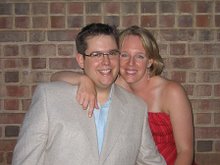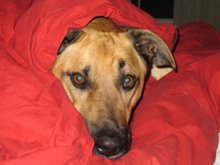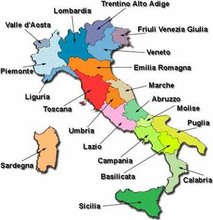Verona is known as piccola Roma (little Rome), and it is easy to see why. The city is very orderly (i.e. streets on a grid) and we really were reminded of Roma when we were there (Verona even has it's own River-the Adige). The city's golden age came during the 13th and 14th centuries (this is the time period Shakespeare wrote about in Romeo and Juliet). This period was also known for the savage family feuding that Shakespeare portrays.
Below is S. Giorgio, a church and a park. This is the first dog park we took Ollie and Mary to. It seems that when the city of Verona was being planned, space was set aside for parks which is really nice! This particular dog area was set within a larger park. I don't think there is this much green in all of Siena!

Close up of S. Giorgio.

Another church. I'm not quite sure the name of it. Possibly S. Stefano.

A view towards Ponte Pietro. To the right is the hill that leads up to the ruins of a castle which is a park and dog area now. You can just make out the castle walls, which you can walk along and let your dog run. We went up to the castle park on Monday but did not make it around the walls on this trip.

Ponte Pietro is a foot bridge that leads to the centro of Verona. Hitler bombed all the bridges as he retreated from Verona. The large, lighter bricks that are visible in the picture below is the original bridge.

View along the Adige.

Another church. Name unknown to me!

Street corner in Old Verona.

Street in centro. Lights had already been put up in the centro and it was really festive. The streets are quaint and have all sorts of neat little stores and shops.

It is hard to see in this picture but hanging from ropes tied across the street were little white cherub angels. We tried to get a close up picture but were unsuccessful.

Vegetables at a fruit stand. Even though it was pretty cold, all the vegetables and fruit were outside.

Piazza delle Erbe (pictured below) was once the sight of a Roman Forum. Today it is the center of the city and there is a market almost every day. In the center of the photo is the Madonna Verona Fountain, which was designed in 1368. The statue is however, a Roman statue that is much older and was added to the fountain.


The tourist office is now in Palazzo Maffei, which is at the North end of the Piazza. This is one of the few Baroque buildings in the town. Along the top of the building you can see sculptures of the six pagan divinities (only 5 are shown in the picture): Jupiter, Mercury, Venus, Apollo, Hercules, and Minerva.

Close up view. Verona was for a long part of the Venetian Empire, whose symbol was the lion.

Buildings surrounding Piazza delle Erbe.

These are the arches that separate Piazza delle Erbe from Piazza del Signori. The one furthest away is Arco della Costa and if you look closely (click on picture) you can see a whale bone suspended from the arch. According to legend, it will fall on the first "just" person to walk beneath it.

Piazza dei Signori. Just beyond the piazza in a courtyard you can see excavation work that has been done to reveal parts of the old Roman city. It is quite interesting. Also part of this piazza is the Palazzo degli Scaligeri, the home of the Scaligeri family which ruled Verona for a number of years.


The Roman Arena is one of the biggest and best preserved arenas. It was built in the first century and now houses Verona's opera. The arena, made of pink marble from Verona (similar to the baptistry in Parma) is the third largest Roman amphitheater in existence, capable of seating 20,000+.


After walking around we decided to grab a few drinks. We stopped at 2 different enotecas. At the first one we had a really good Valpolicella, a red wine from the Veneto region. It ranks just after Chianti in total Italian D.O.C. and is made from three grape varietals: Corvina Veronese, Rondinella, and Molinara. We also tasted a few antipasti including polenta that is served with gorgonzola and some salumi and lardo. We moved on to another enoteca where I was able to have a glass of Moscato for 2 Euros- not bad!
After all that, we headed off to Caffe Antica Osteria al Duomo, one of Lawren and Steve's favorite restaurants. It is really rustic and really good. Reed and I split two primi: a thick pasta (very similar to pici) that had a ragu made with asano (donkey) and a gnocchi with horse and ruccola which was also really good (I liked the donkey more and Reed liked the horse). For a secondi we split bresaola that was served with ruccola and lemon. This was probably our least favorite but still really good (bresaola is an air-dried salted beef). We were too hungry to take any pictures of the food-next time!

Osteria al Duomo
Via Duomo, 7
Verona
045 800 4505
Via Duomo, 7
Verona
045 800 4505
Tomorrow we head to Venezia to see some gondolas and canals!








No comments:
Post a Comment